I have a 2002 Toyota Corolla (1zz-fe engine) and I am getting a P0171 code - lean condition. I am trying to make sense of my fuel trim values and I was hoping someone could help understand these results:
- I am measuring on Neutral, after the engine warmed up.
- At idle (about 700 RPM) my LTFT is steady at 31% and my STFT is between 4-6%.
- At 2,500 RPM, both FTs drop but seem to be doing opposite things: LTFT goes to 22% (remains positive) and STFT drops to -4% - 0% (becomes negative).
- Going up to 3,200 RPM, the 2 FT are going in opposite directions: LTFT goes back up to 31% and STFT drops to -20%.
I am not understanding why ST and LT seem to be competing (adding / removing fuel), and also why they are going in opposite directions at higher RPM.
If somebody could help, or tell me what to test next it would be really helpful!
Thanks a lot